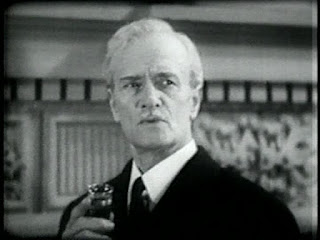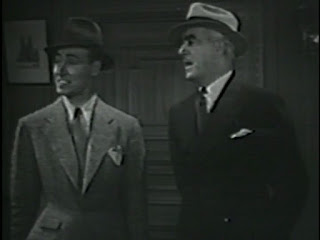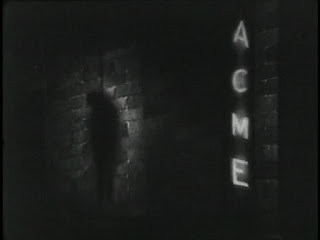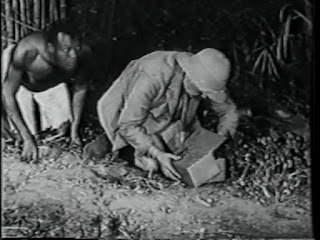"Two entries in one day?!", you ask? Yes, dear readers: for now we have our fourth retrospective, and our 100th blog post, covering the 50 movies that comprise the Night Screams subset of our 250-film box set from Mill Creek. As it happens, Night Screams was 100% unchanged when it was incorporated into the big box, so this retrospective applies just as well to the standalone box.
And, dear readers ("Wait, you just called us that"), this one was a slog to get through. Night Screams is loaded with self-similar movies from the 1930s whose titles offer us little hope of differentiating between them; in fact, we had to add a whole new category just for pairs of films that resemble each other to an uncomfortable degree. But after some blood, sweat, toil and tears, we've come up with a slate of winners...
...and losers: Night Screams also has some of the very worst films we've seen on this box set.
As ever, some categories reappear from past awards ceremonies (see here, here, and here for those), while others simply didn't apply to this bunch: once again, we really couldn't come up with anything that deserved to be called "so bad it's good". This time around it's only been eight months since our last ceremony, which speaks more to our tremendous backlog (now resolved) than our overall work ethic.
Now, to quote Ultimate Spinach, behold and see our nominees:
Actual Best Movie Award:
House of Danger
The House of Secrets
The Phantom Express
The Ticket of Leave Man
Wanted: Babysitter (aka Scar Tissue)
Winner: The Phantom Express
Not the strongest field for this category, and frankly House of Danger and The House of Secrets may be benefiting somewhat from recency effect here. In any event, when you account for the sloppiness of Wanted: Babysitter and the anti-Semitism of The Ticket of Leave Man, the only option left is also the movie we enjoyed most, The Phantom Express.
Is it the 1930s version of feel-good pap? Maybe -- but feeling good is nice sometimes.
Actual Worst Movie Award:
The Crooked Circle
A Face in the Fog
The Ghost and the Guest
House of Mystery
The Phantom
Winner: The Ghost and the Guest
This category, on the other hand, was extremely competitive. ZaSu Pitts annoyed us to no end in The Crooked Circle, while The Phantom was torturously slow, A Face in the Fog assertively unfunny, and House of Mystery abrasively stupid.
But The Ghost and the Guest represented something very close to an all-time low in our film-watching career, had no redeeming qualities whatsoever, and was smirkingly racist to boot. Thus, it gets the aforementioned boot.
Nicest Nautical Narrative:
Killers of the Sea
Manfish
Night Tide
A Passenger to Bali
She Gods of Shark Reef
Winner: Manfish
We wanted to pick Killers of the Sea here, since we quote it with some regularity, and K.'s picture review is probably P.'s single favorite thing about our site.
However, innocent animals were harmed in the making of that film -- so it's certainly not "nice" -- and it's barely a movie. So Manfish gets the crown, which isn't hard to do when your competitors are a miscast Dennis Hopper, an overripe retelling of the Flying Dutchman legend, and a half-assed "nubiles on an island" effort.
Still, we really did like Lon Chaney Jr. in Manfish, even if he's just doing a recycled Lennie act.
The Eye Candy Award:
Carnage
The Embalmer
Kiss Me Kill Me
The Lion Man
A Scream in the Night
Winner (tie): Carnage and Kiss Me Kill Me
The cute extra in A Scream in the Night is only onscreen for a couple of seconds, while the also-nameless minor character who lights up the screen in The Embalmer gets little more, so we have to rule them out for insufficient data.
Meanwhile, Kathleen Burke is pretty in The Lion Man, but for us it really comes down to Leslie den Dooven in Carnage vs. Isabelle de Funès in Kiss Me Kill Me. Quirky selections, we suppose -- but since we're running a two-person operation here, and each of us has our preferences, let's call it a draw.
Honorable Mention: Mickey Hargitay in Bloody Pit of Horror. No wonder he ended up marrying one of the bombshells of his day, as he was a fine-looking man, handsome and unexpectedly agile.
The Scorched Earth Award:
Death Warmed Up
Grave of the Vampire
Sisters of Death
The Tell-Tale Heart
Winner: Sisters of Death
Though we don't want to spoil them, let's say that the survival rate for the principals of these films, and the level of moral purity they're able to maintain, could both be described as...sub-optimal. Given those criteria, the laurels have to go to the titular Sisters of Death, whose monotonic incantations give way to a symphony of mayhem, with a 1970s style that seals the deal.
The Hoist with Their Own Petard Award:
Bloody Pit of Horror
Death Warmed Up
Frankenstein 80
Son of Ingagi
Winner: Death Warmed Up
Again, we don't want to spoil anything, but it's not a big surprise to note that -- at least in the movies -- scientists (and other aficionados) who experiment on non-consenting subjects sometimes find themselves on the receiving end. Death Warmed Up plays the longest game in that regard, so this sprawling, incoherent, occasionally fun New Zealand horror epic is our pick.
The IWGIHs Award:
A Face in the Fog
The Invisible Killer
The Phantom of 42nd Street
Strangers of the Evening
Winner: A Face in the Fog
A Face in the Fog is what led us to name this category in the first place, so it's no surprise that it wins -- but it doesn't do so on the basis of seniority alone: more than any other film on this list, it's seriously afflicted by a total failure to differentiate between the identical-looking, similarly-dressed (and -hatted) white men who make up its character roster.
The Rich Are Not Lke You and Me Award:
Green Eyes
Murder at Midnight
The Savage Girl
Winner: The Savage Girl
Elaborate masquerade parties, and putting on a one-act play for the sake of a game of charades -- those things are weird. But being able to say on a moment's notice "Hey, I feel like going to Africa...oh, you want to go too? Cool, come along and bring your taxicab"? That's on an entirely different level.
The Know-It-All Award:
Green Eyes
The Midnight Warning
The Thirteenth Guest
Winner: Green Eyes
"Stage" Boyd and Lyle Talbot are a bit insufferable in their respective roles as all-knowing detectives (especially Talbot), sure. But Charles Starrett, who already looks a hell of a lot like John de Lancie, is so appallingly cocksure and omniscient that it's literally as if Q himself is making a cameo in Green Eyes, right down to his ridiculous outfits.
The "You're, Like, the Same Movie" Playoffs:
Anatomy of a Psycho vs. Buried Alive
In these tales of capital punishment and bitterness, Buried Alive gets the nod for its far more engaging plot and DT love story.
City of Missing Girls vs. The Devil's Sleep
Oh, no contest here -- in these sordid tales of vice and blackmail, we'll take H.B. Warner's spry wit in City of Missing Girls any day over Mr. America and The Devil's Sleep.
Bloody Pit of Horror vs. The Dungeon of Harrow
Mickey Hargitay, plus at least Bloody Pit of Horror can pronounce its own protagonist's name.
The Ghost and the Guest vs. Ghosts on the Loose
Newlyweds, zany characters, spooky old houses, and confusion, but one of these movies should be thrown in a fire. The other one has Béla Lugosi. Guess which one we liked better?
I Killed That Man vs. Midnight Phantom
Nobody leaves this room until we find out which film is better! Well, that's easy: I Killed That Man was sort of fun, Midnight Phantom was a structural disaster, so the movie with the silliest pajamas wins.
The Face at the Window vs. The Ticket of Leave Man
While we prefer our Tod Slaughter films to be free of anti-Semitic caricatures, The Ticket of Leave Man is still a better effort than The Face at the Window, which depends too much on woo-woo science and stupid protagonists for its own good.
Drums of Africa (Jungle Man) vs. Nabonga vs. The Savage Girl
Despite a good one-liner (and a couple of well-placed meaningful glances) in Jungle Man, it probably has to be The Savage Girl, which makes the best use of its inevitable stock footage and moves along at a nice clip.
Special Awards for Special Campers:
Best Spoonerism Award:
We've been waiting for, like, years to note this: Daughter of the Tong makes for a truly extraordinary spoonerism -- and a readymade title for a very blue film.
(Bonus points for singing it to the tune of the Underdog [sic] part from The Doors' "The Soft Parade".)
The Most Contrived Catchphrase Award (tie):
If only ZaSu Pitts had kept boasting "Smooth as silk!" in The Crooked Circle, and Lon Chaney Jr. had repeatedly lamented that "Something always happens to somebody!" in Shadow of Silk Lennox, both films would have been immeasurably improved. As it stands, we're stuck with what we have.
The Bury the Lead Award (tie):
Screenwriters who use the "And the name of the killer is...(hurk)" device that shows up in A Shot in the Dark and I Killed That Man need to be cattle-prodded in the buttocks. Friends, if you're ever calling out a murderer, lead with their name.
The "And Loosens Up Our Pecs" Award (tie):
A Shot in the Dark and The Phantom of 42nd Street have a weird correspondence with each other: both films have a hanged man depicted in silhouette, and a character with a particularly deep, resonant voice. (The two actors in question even look fairly similar.) So maybe that Ren & Stimpy song was right?
The Holy-Crap-How-Long-Has-It-Been? Award:
We watched (and reviewed) The Wasp Woman back in 2009! Two-thousand-freakin'-nine, for pity's sake! How on earth can it have been that long? We remember an interesting face, "royal jelly", murder by barbell, and not much else about what turns out to have been our first foray into Night Screams.
So, after nearly a decade on this project -- and a heroic effort to overcome our backlog -- we're now down to the last 50 or so movies. It's more like 44, actually, since we've already watched the likes of Eegah and Santa Claus Conquers the Martians.
Will we finish 50 Sci-Fi Classics in time for its awards ceremony to coincide with the 10-year anniversary of our site? Well, p'têt ben que oui, p'têt ben que non: we don't like to make those sorts of promises here at the Umbrellahead Review. But we'll see.
Will we finish 50 Sci-Fi Classics in time for its awards ceremony to coincide with the 10-year anniversary of our site? Well, p'têt ben que oui, p'têt ben que non: we don't like to make those sorts of promises here at the Umbrellahead Review. But we'll see.































































